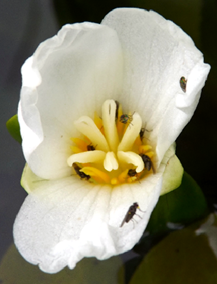Mutualism of Stratiotes aloides L. (Hydrocharitaceae) and Hydrellia tarsata Haliday (Diptera: Ephydridae): Tritrophic interaction of macrophyte, leaf-mining dipteran pollinator and parasitoid Braconidae
DOI:
https://doi.org/10.26786/1920-7603(2015)3Abstract
The aquatic macrophyte Stratiotes aloides L. is of conservation concern in central Europe due to its high importance for biodiversity in lowland floodplain and ditch ecosystems. However, over the last decades this species has shown population declines for instance in Germany or the Netherlands. S. aloides is dioecious with male and female individuals, in mixed or separated stands, often reproducing vegetatively. Generative reproduction is observed less frequently, but of great importance for declining plant populations facing threats of habitat destruction and eutrophication. Precisely which arthropods transfer S. aloides pollen was previously unknown. We examined flower visitors of S. aloides in the 2011 and 2014 flowering seasons in ditches of a wet grassland ecosystem in Bremen, Northwest Germany. Hydrellia tarsata Haliday (Diptera: Ephydridae) was found abundantly in male and female flowers of S. aloides in both years. Pollen of S. aloides was actively transferred by H. tarsata and reproduction of the fly in S. aloides leaves was detected by rearing H. tarsata from extracted puparia. The mining Hydrellia were parasitised by the braconid wasps Chaenusa “punctulata” Burghele and Chorebus “densepunctatus” Burghele, which also visited S. aloides flowers in 2011 and 2014. These results point to a mutualism between S. aloides and the ephydrid H. tarsata, with both partners benefiting with their own reproduction. This relationship between plant and dipteran pollinator is however complicated in a tritrophic interaction with the braconid parasitoids, which infest the mining stages of the ephydrid flies and could potentially also transfer S. aloides pollen.

Downloads
Published
How to Cite
Issue
Section
License
Copyright (c) 2015 Jakob Katzenberger, Dietmar Zacharias

This work is licensed under a Creative Commons Attribution 4.0 International License.
JPE is an open access journal which means that all content is freely available without charge to the user or his/her institution.
Authors who publish with this journal agree to the following terms:
1) Authors retain copyright and grant the journal right of first publication with the work simultaneously licensed under a Creative Commons Attribution License that allows others to share the work with an acknowledgement of the work's authorship and initial publication in this journal.
2) Authors are able to enter into separate, additional contractual arrangements for the non-exclusive distribution of the journal's published version of the work (e.g., post it to an institutional repository or publish it in a book), with an acknowledgement of its initial publication in this journal.
3) Authors are permitted and encouraged to post their work online (e.g., in institutional repositories or on their website) prior to and during the submission process, as it can lead to productive exchanges, as well as earlier and greater citation of published work (See The Effect of Open Access).
To assure a broader targeted audience, content will be included into databases (such as EBSCO) and directories (such as DOAJ).











